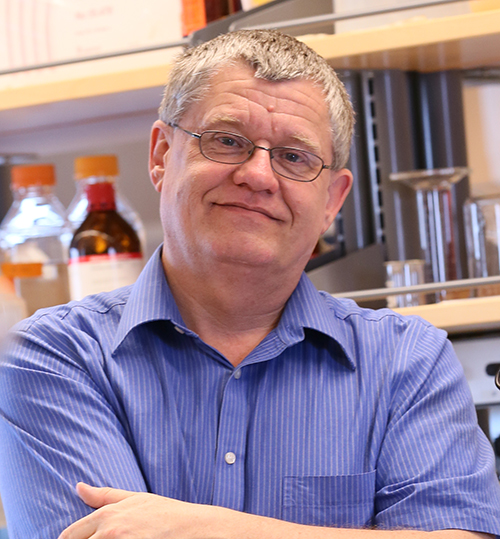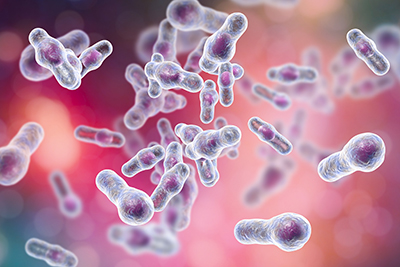Research, News & Discoveries
-

New method captures early viral-host protein interactions
May. 7, 2020, 10:43 AM by Bill Snyder More than 70% of all viruses known to cause human disease, including the one that causes COVID-19, are RNA viruses. They invade the body by hijacking the internal machinery of cells. Yet little is known about how viral RNA commandeers host… Read MoreMay. 7, 2020
-

A dual-purpose metabolic switch
May. 5, 2020, 8:00 AM by Leigh MacMillan Compounds called inositol diphosphates are cellular signaling “codes” involved in multiple processes ranging from phosphate sensing to DNA metabolism. John York, PhD, and colleagues have demonstrated that the evolutionarily conserved gene product Vip1 is capable of both synthesizing… Read MoreMay. 7, 2020
-

Antibody finding raises hopes for Marburg, COVID-19 treatments
Apr. 30, 2020, 10:00 AM by Bill Snyder Marburg is a distant, more lethal cousin of the RNA virus that causes COVID-19. An outbreak of Marburg hemorrhagic fever in Angola in 2004-2005 killed 90% of the approximately 250 people it infected. Now researchers at the University of Texas Medical Branch… Read MoreMay. 7, 2020
-

Regulating protein synthesis genes
https://cdn.vanderbilt.edu/t2-main/medschool-prd/wp-content/uploads/sites/101/2020/05/Tansey_website.mp4 By Suneethi Sivakumaran WDR5 has different moonlighting roles in the body, including in chromatin regulation and in chromatin-independent processes such as cell division. © Ian Dyball, stock.adobe.com The human body is a complicated network of interdependent cellular processes regulated by gene-encoded proteins. Proteins… Read MoreMay. 6, 2020
-

Warren Foundation to further treatments for brain disorders
by Ryan Underwood May. 5, 2020, 2:00 PM New gift establishes the Warren Center for Neuroscience Drug Discovery to support pharmaceutical breakthroughs Vanderbilt University received $20 million from The William K. Warren Foundation, located in Tulsa, Oklahoma, to establish the Warren… Read MoreMay. 5, 2020
-

Transporter’s role in gut barrier
Apr. 16, 2020, 11:00 AM by Leigh MacMillan The cotransporter NKCC1 moves sodium, potassium and chloride ions across the cell membrane of many cell types, including intestinal epithelial cells. Two patients with mutations in NKCC1 suffered from severe intestinal dysfunction and chronic infections. To explore the cellular and molecular mechanisms underlying the… Read MoreApr. 29, 2020
-

Preventing CDI deaths one stem cell at a time
https://cdn.vanderbilt.edu/t2-main/medschool-prd/wp-content/uploads/sites/101/2020/04/Lacy_Website.mp4 By Sara Eaton C. diff is responsible for 50% of gastrointestinal infections in hospitals but cause over 90% of GI tract infection-related deaths. © Kateryna_Kon, stock.adobe.com Gastrointestinal infections often cause damage to the stem cells in the colon’s epithelium, a thin layer of… Read MoreApr. 23, 2020
-

New Dean’s Faculty Fellows program recognizes early-stage faculty
By Lorena Infante Lara Manuel Ascano, Department of Biochemistry, and Marija Zanic, Department of Cell and Developmental Biology. The School of Medicine Basic Sciences has established a new Dean’s Faculty Fellows program designed to recognize the efforts of faculty in the early stages of their career. The award targets assistant… Read MoreApr. 21, 2020
-

New Dean’s Faculty Fellows program recognizes early-stage faculty
By Lorena Infante Lara Manuel Ascano, Department of Biochemistry, and Marija Zanic, Department of Cell and Developmental Biology. The School of Medicine Basic Sciences has established a new Dean’s Faculty Fellows program designed to recognize the efforts of faculty in the early stages of their career. The award targets assistant… Read MoreApr. 21, 2020
-

‘Tuning’ cell shape for division
Apr. 16, 2020, 1:00 PM by Leigh MacMillan Mechanical properties of the cell cortex — a thin network of actin filaments under the cell membrane — regulate shape changes during cell division, cell migration and tissue development. Two forms of the molecular motor myosin-II participate in organizing and remodeling the… Read MoreApr. 17, 2020